Research
My research centres on understanding the interstellar medium, or "ISM", of galaxies (the material floating in the space between stars) — what its properties are, and what it can tell us about how galaxies have changed over the history of the Universe. I especially focus on cosmic dust, and the unique window it provides onto how galaxies have developed from clouds of basic primordial gas into evolved systems — enriched with the heavy elements that go on to form new stars and planets (and occasionally astronomers). My scientific home at STScI is the supportive & excellent ISM*@ST research group.
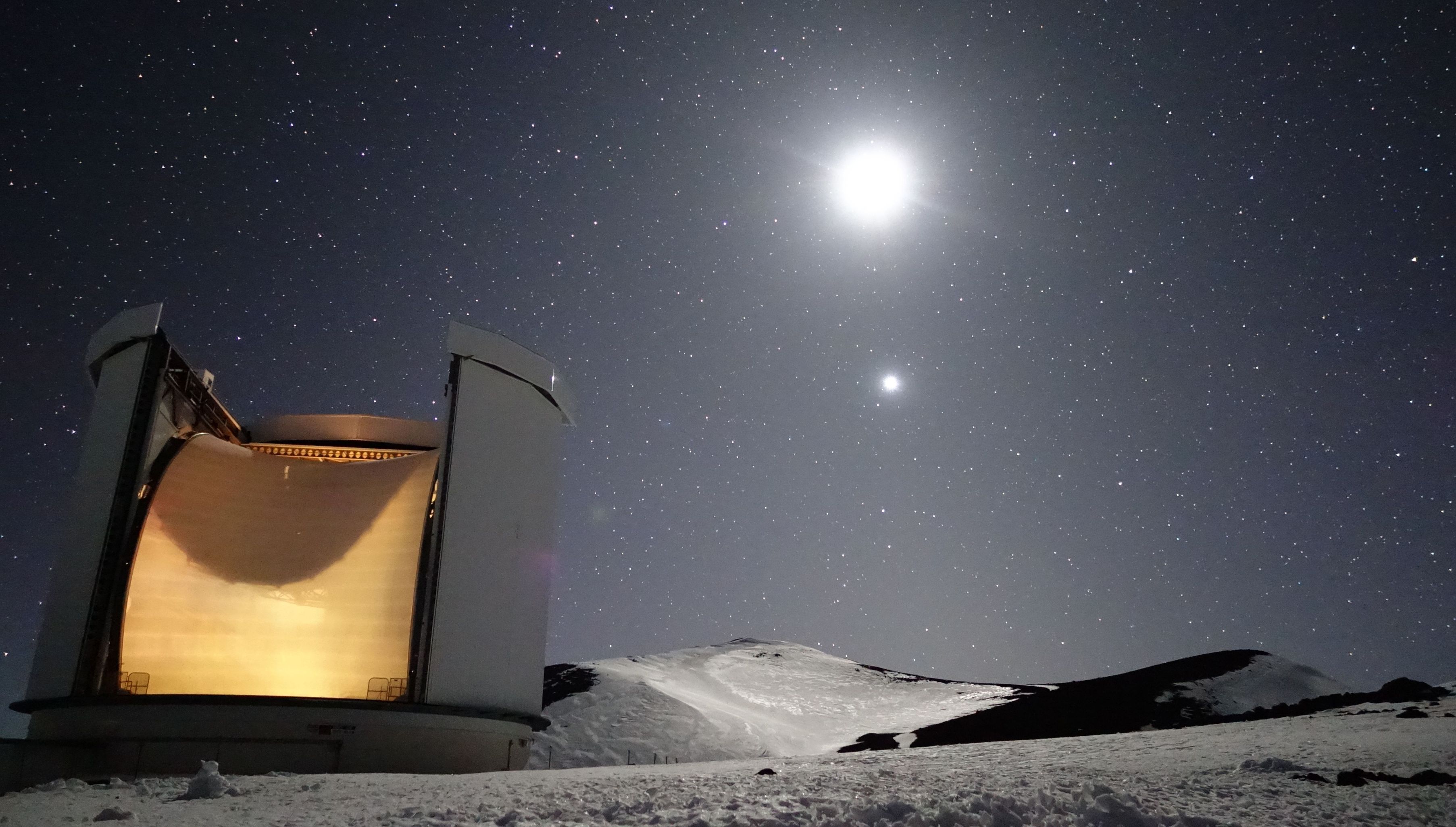
The James Clerk Maxwell Telescope, at the summit of Mauna Kea on Hawai'i, observing for the JINGLE survey during my New Year 2017 observing run (with Venus & the Moon shamelessly photobombing in the backround).
I am currently a European Space Agency / AURA Astronomer at the Space Telescope Science Institute, investigating how the properties if the ISM change within and between nearby galaxies, and how this traces galaxy evolution. I was previously a postdoctoral fellow at STScI, and before that a postdoctoral research associate at Cardiff University, where I did my PhD.
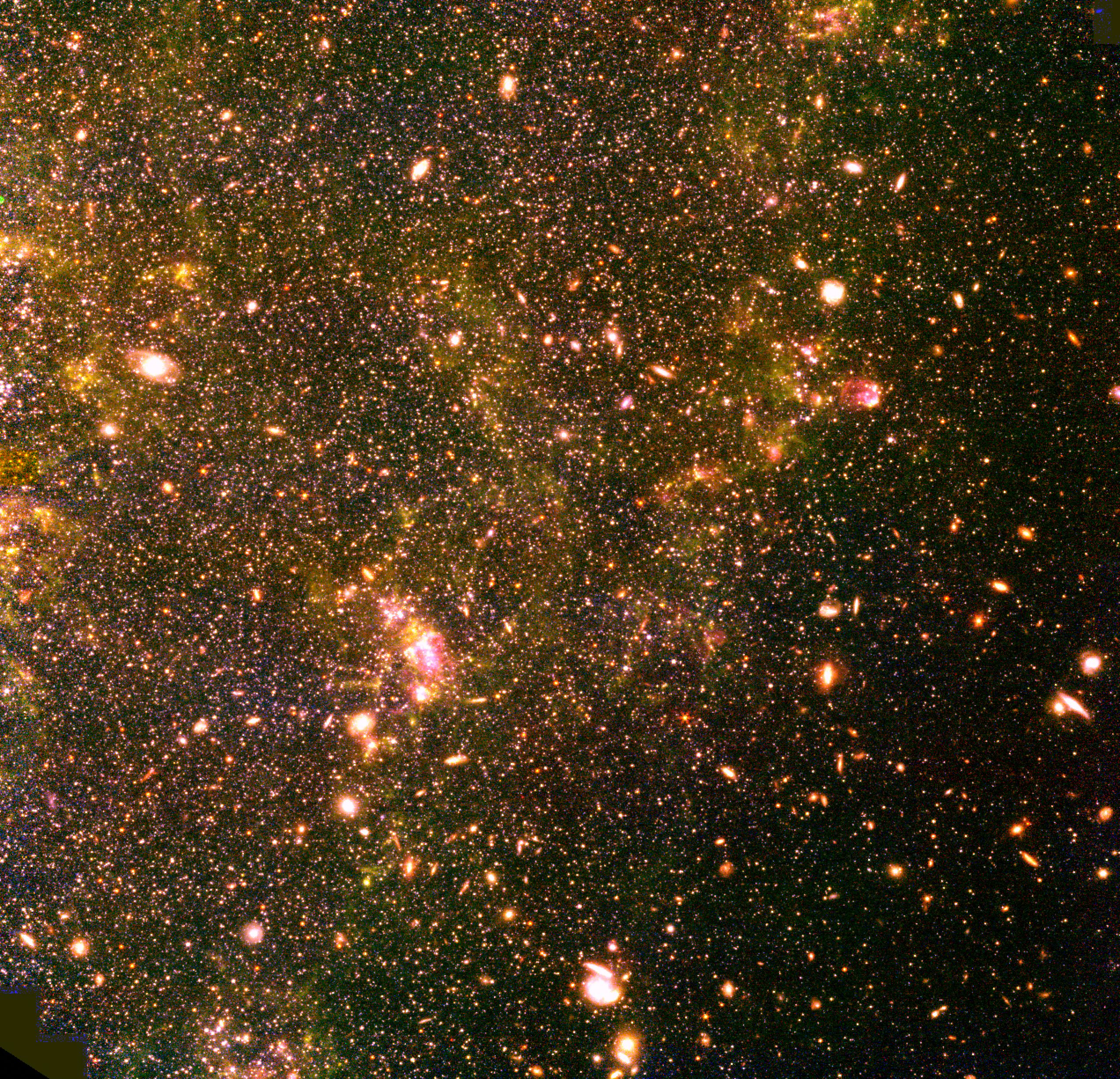
Preliminary JWST NIRCam data from our first field in M101 to be observed. RGB channels assigned to F090W, F335M, and F444W, respectively. Blue shows stellar & ionised hydrogen emission; green show emission from carbonaceous nanoparticles (with some stellar emission); red shows stellar & hot dust emission.
In 2025, we have been exploring the data the our 25 hour JWST program that I am leading. In this program, we're aiming to pin down the factors driving the variation in emission from carbonaceous nanoparticles (often called PAHs), especially with respect to metallicity, via a comprehensive multi-parameter benchmarking M101. We will use MIRI and NIRCam imaging to map the strengths of the 3.3, 7.7, and 11.3 um carbonaceous emission features across 6 fields in M101. M101 provides an unparalleled 'controlled laboratory' for this investigation, and has exquisite ancillary data. Our fields sample 0.93 dex in metallicity, 1.6 dex in neutral gas surface density, 2.6 dex in ionized gas surface density, and 3.0 dex in UV radiation field strength. Our data will provide >3500 measurements of each feature with 2" resolution, giving us the statistical power to disentangle the phenomena driving carbonaceous evolution, by seeing how one parameter varies whilst others are held constant. With this data, will be able to tackle open questions about the formation, evolution, and destruction of carbonaceous nanoparticles; and test existing models in a uniquely wide range of environments.

NASA's SOFIA observatory in flight, with the telescope doors open. (Image credit NASA / Jim Ross; public domain.)
I have also been awarded time to use NASA's flying telescope, the Stratospheric Observatory For Infrared Astronomy (SOFIA; since tragically decommissioned). In Clark et al. (2025) we used this data to demonstrate a new way of measuring the abundance and depletion of carbon in the ISM, via the novel approach of measuring absorption of the 158 μm [CII] line, using far-infrared-bright nearby galaxies as background sources. Despite carbon being one of dust's main constituents, we still don't have a good idea of what fraction of all carbon is actually locked up in dust; this method demonstrates a new way to trackle this problem, especially with future far-infrared facilities
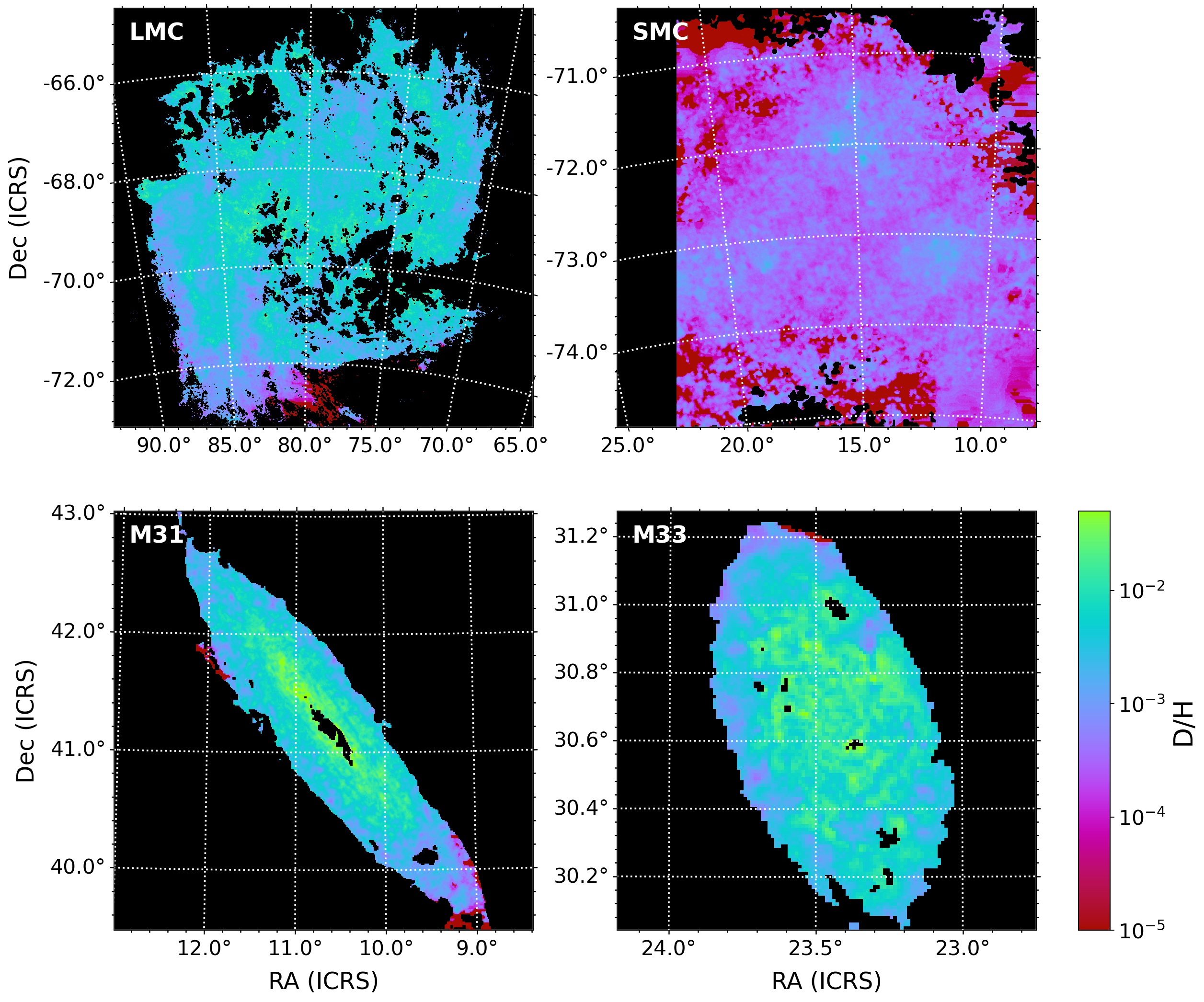
Maps of how the dust-to-gas ratio varies within the four largest galaxies in our Local Group: the Large Magellanic Cloud, the Small Magellanic Cloud, M31, and M33. Large variations in dust-to-gas ratio can be seen both within and between these galaixes (driven mainly by changes in density and in metallicity, respectively).
In Clark et al. (2023), I explore how the dust-to-gas ratio (one of the fundamental measures of a galaxy's chemical evolution) varies within the four largest galaxies in the Local Group. I show that the dust-to-gas ratio can vary with density by over a factor of 20 within a single galaxy, far more than previously thought. This is strong evidence for high levels of dust grain growth in the denser regons of the interstellar medium of galaxies. I also demonstrate that dust-to-gas properties can differ markedly between similar-appearing galaxies. This work was the subject of a NASA-JPL press release, and covered by publications worldwide.
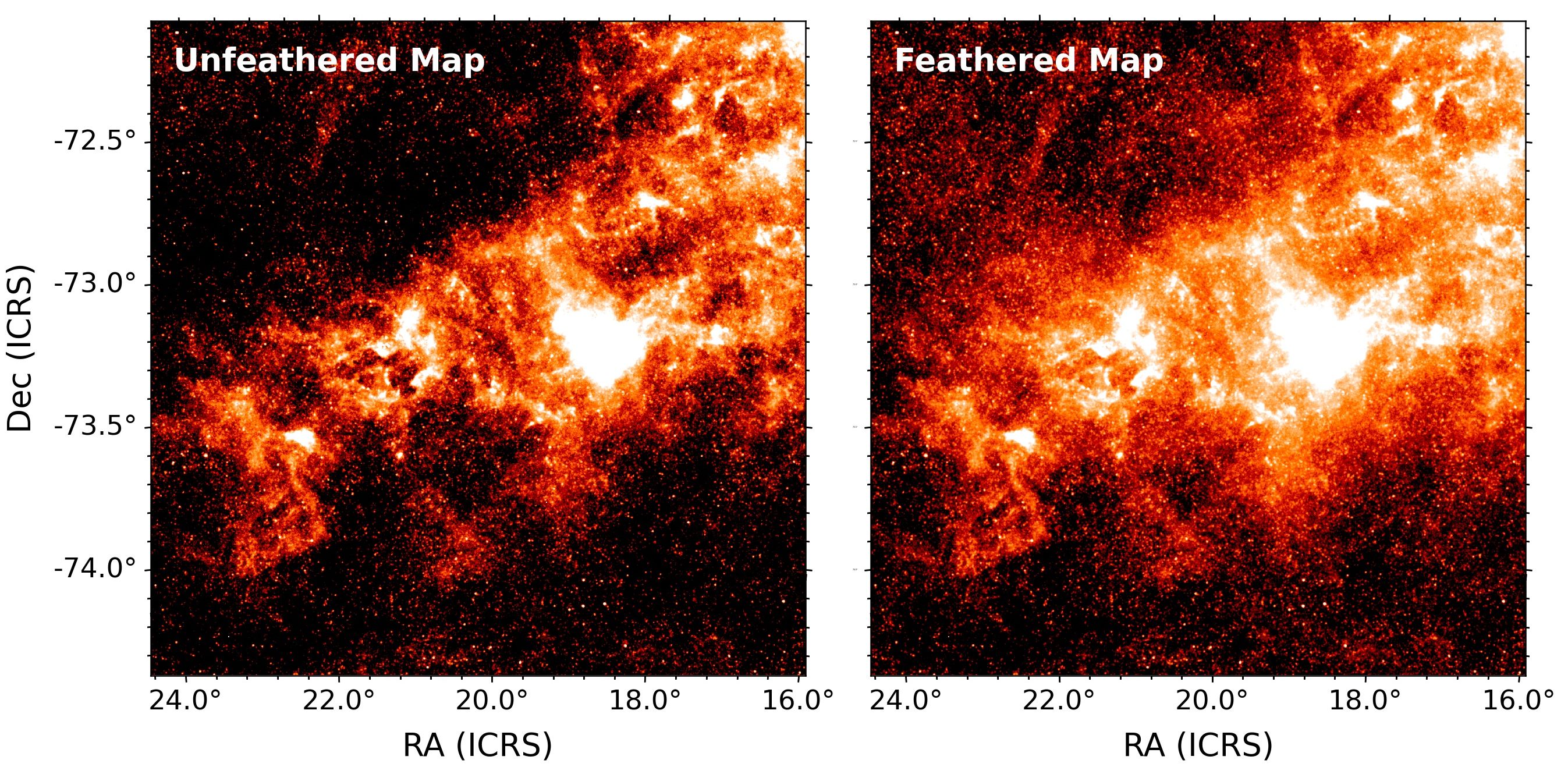
A comparison of an original map of the Small Magellanic Cloud galaxy (left), compared to my new corrected map (right), with previousy-missed dust emission restored via "feathering".
In Clark et al. (2021), I produced new Herschel Space Observatory maps of nearest, most-extended galaxies in the sky: the Local Group galaxies Andromeda (M31), Triangulum (M33), the Large Magellanic Cloud (LMC), and the Small Magellandic Cloud (SMC). Previous Herschel maps of the these galaxies missed a large fraction (over 20% in some cases) of the total flux present, becuase Herschel is unable to detect very extended emission. However, using a technique called "feathering", I was able to combine the Herschel data with observavtions from other telescopes (Planck, COBE, and IRAS). My new maps capture the diffuse extended dust emission that was previously missed, whilst still preserving the excellent resolution provided by Herschel. These new maps enabled me to detect dust in exceptionally low-density environments, below ΣH = 1 M☉ pc-2.

A Hubble Space Telescope image of extremely metal-poor galaxy Leo P, showing the stars we will use to measure extincton due to dust (crosses), and the regions within which we will combine extinction meaurements to map Leo P's dust mass (lines). Also marked are potential dust sources and sinks: purple hexagons are dusty evolved stars; the red ring is a candidate supernova remnant; the double orange ring outlines Leo P's HII region; and the pink circles indicate areas of higher density atomic gas.
In 2020, I succesfully proposed for time on the Hubble Space Telescope to observe the extremely metal-poor dwarf galaxy Leo P. The prperties of the ISM in such primitive galaxies are poorly understood, especially how & where dust forms, the role of dust role in creation of molecular gas, and the charactaristics of dust at low metallicity. By using Hubble to observe Leo P in multiple UV–optical–IR wavelengths, we will be able to measure the dust extinction along the line-of-sight to many hundreds of its stars. By combining extinction measurements for stars located close together, we will be able to create a map of dust in Leo P. This will tell us where the dust is, how much of it there is, its properties, how it relates to Leo P's various potential sites of dust creation and destruction. Leo P is the only extremely metal-poor galaxy close enough for us to perform this sort of analysis, and can provide a window on how the ISM evolves in primirtive galaxies in the early Universe.
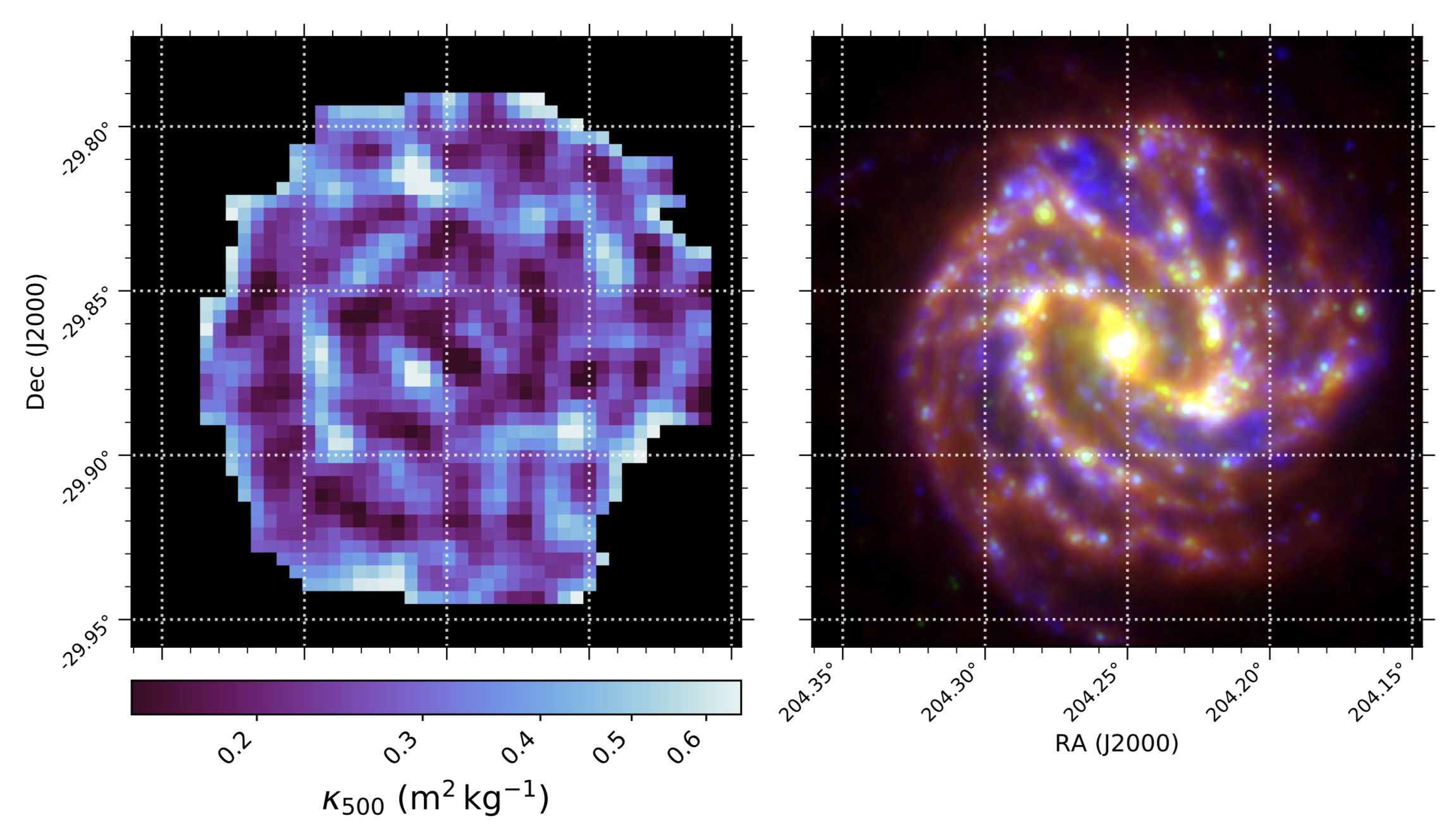
The first map of the dust mass absorption coefficient, κd, in a galaxy, for nearby spiral M83. The panel on the left shows the map of κd, whilst the panel on the right shows a multiwavelength reference image of M83 for comparison (where blue is ultraviolet, green is near-infrared, and red is far-infrared).
In 2019, I created the first ever maps of the dust mass absoroption coefficient in galaxies, showing how it varies within nearby spirals M74 and M83. The dust mass absorption coeffecient, κd, is what astronomers depend upon to calculate the actual mass of dust in a system, from observations of the dust's thermal emission. However, its value is notoriously poorly constrained, and it was previously totally unknown how it varied within galaxies. In Clark et al. (2019), we show that κd appears to be lower in regions of denser ISM - this is the opposite of what had been predicted by models, but the result cannot be avoided without making unphysical or contrived alterations to our method.

Multiwavelength imagery of DustPedia galaxy NGC 3686, showing the apertures used by the CAAPR photometry pipeline to measure the galaxy's flux in each of the 26 ultraviolet—submillimetre wavelengths shown. CAAPR performed this process for all 875 DustPedia galaxies; see Clark et al. (2017).
In Clark et al. (2018), I describe the extensive database of imagery and photometry that I created for the DustPedia project, covering 875 nearby galaxies and spanning 42 ultraviolet—microwave bands. For this, I created the publicly-available CAAPR photometry pipeline, tailored to handle the difficult task of automatically conducuting robust aperture-matched photometry for nearby galaxies.

Microscope image of a liver tissue section, as processed by my AstroCell software. The original image is shown in the top-left panel, with the other panels showing the results of AstroCell automatically identifying and classifying the cells.
In 2017, I was awarded funding by the Data Innovation Research Institute to take image-analysis techniques used in astronomy, and apply them to microscope imagery of cancerous tissues, in collaboration with the School of Biosciences at Cardiff University. When studying microscope images of tissues, cancer researchers still regularly count and classify the many thousands of cells by hand — whereas in astronomy we use software to detect and analyse the stars and galaxies in our data. I worked on developing AstroCell, a user-friendly and freely-available piece of software to count and classify cells (in contrast to the complex, specialised, and typically commercial software generally avaialble).

Compilation of values for κd (the dust mass absorption coefficient) published 1984—2019. This shows show poorly-constrained κd is, with values spanning over 3 orders of magnitude! The empirical value reported in Clark et al. (2016) is shown in blue. The range of values I find in M74 and M83 in Clark et al. (2019) are shown by the shaded purple bars.
In Clark et al. (2016), I used data from the Herschel Reference Survey to empircally determine a value for κd (the dust mass absorption coefficient), the notoriously-poorly-constrainted conversion factor that astronomers need to work out dust masses. By taking advantage of the fact that the dust-to-metals ratio in the ISM only shows minimal variation, I find a value of κd at 500 μm of 0.051 (+0.070, −0.026) m2 kg−1.
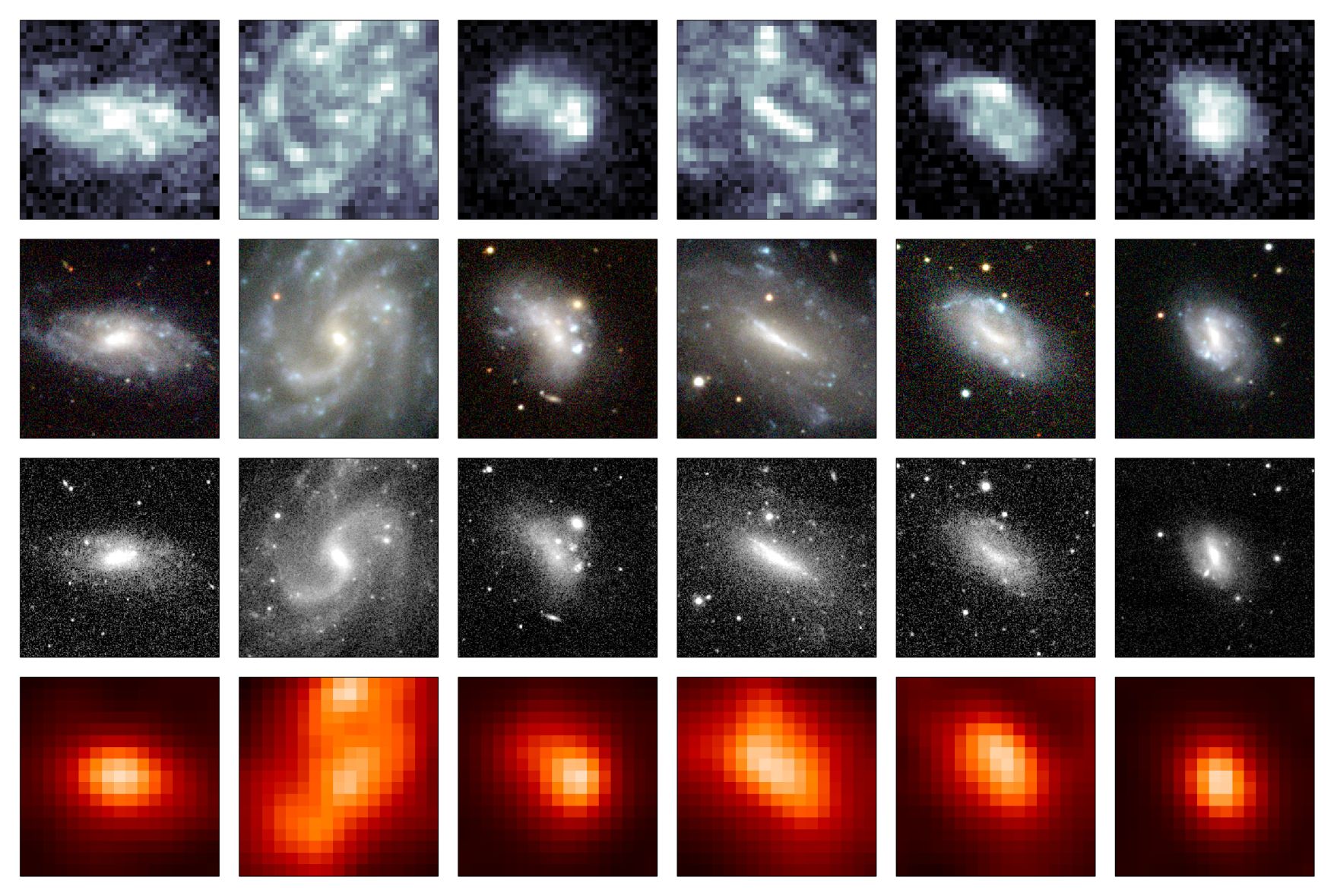
Six of the enigmatic blue and dusty gas rich galaxies revealed in Clark et al., 2015, as they appear in four different parts of the spectrum. Note their abundant star formation (in the ultraviolet, 1st row), irregular and flocculent morphologies (in the optical, 2nd row), modest populations of evolved stars (in the near-infrared, 3rd row), and dust-richness (in the submillimetre, 4th row).
For my PhD thesis (and published in Clark et al., 2015), I used Hershcel-ATLAS to create the first dust-selected volume-limited survey of nearby galaxies, providing our first unbiased view of dust in the local Universe. Unexpectedly, I found that most dusty galaxies belong to a severely under-studed population dubbed 'BADGRS' — Blue And Dusty Gas Rich Sources (examples shown above). BADGRS contain only 5% of the stars in the local Universe, but 35% of the dust, and over 50% of the atomic gas. Their dust is very cold (12—16 K), and absorbs an exceptionally small fraction of their stellar emission. BADGRS represent a fascinating intermediate stage in galaxy evolution. They’ve built up a lot of dust very quickly, and are relatively metal-rich (metallicities of 0.5—1.1 solar); however, they are still early in the process of converting their gas into stars, unlike most commonly-studied galaxies.

Resolved component separation of the Crab Nebula as it appears at 160 μm (published in Gomez et al., 2012), showing the synchrotron (left), warm dust (centre), and cool dust (right) emission. This was the first ever map of the distribution of cold dust manufactured within a supernova remnant.
I also have an active interest in evolved stars, following on from work I carried out for my PhD thesis (also published in Gomez et al., 2012). I used Herschel data to perform a resolved component separation of the far-infrared and submillimetre emission of three supernova remnants, including the Crab Nebula. My resolved component separation for the Crab (shown above) generated the first ever map of the distribution of cold supernova dust within a supernova remnant. This map showed the dust lies protected within the Crab's dense filaments, proving that it was manufacted by the Crab, and showing that the dust will survive to be injected into the Galactic environment — the first remnant for which this can be said.
Publications
First Author
Clark, C.J.R., et al., 2025, Measuring Interstellar Carbon Abundance via 158 μm [CII] Absorption with SOFIA – A Potential Detection, and Proof-of-Concept for Depletion Studies with Future Far-IR Facilities, AJ 170 8
Clark, C.J.R., et al., 2023, The Quest for the Missing Dust: II – Two Orders of Magnitude of Evolution in the Dust-to-Gas Ratio Resolved Within Local Group Galaxies, ApJ 946 42
Clark, C.J.R., et al., 2021, The Quest for the Missing Dust: I – Restoring Large Scale Emission in Herschel Maps of Local Group Galaxies, ApJ 921 35
Clark, C.J.R., et al., 2019, The First Maps of κd – the Dust Mass Absorption Coefficient – in Nearby Galaxies, with DustPedia, MNRAS 489 5256
Clark, C.J.R., et al., 2018, DustPedia: Multiwavelength Photometry and Imagery of 875 Nearby Galaxies in 42 Ultraviolet–Microwave Bands, A&A 609 A37
Clark, C.J.R., et al., 2016, An Empirical Determination of the Dust Mass Absorption Coefficient, κd, Using the Herschel Reference Survey, MNRAS 459 1646
Clark, C.J.R., et al., 2015, Herschel-ATLAS: The Surprising Diversity of Dust-Selected Galaxies in the Local Submillimetre Universe, MNRAS 452 397
Clark, C.J.R., 2015, On the Origins of Cosmic Dust and the Evolution of Nearby Galaxies with the Herschel Space Observatory, PhD thesis
First Author (Non-Peer-Reviewed)
Clark, C.J.R., et al., 2019, Astro2020: Unleashing the Potential of Dust Emission as a Window onto Galaxy Evolution, Science white paper, Astro2020 Decadal Survey on Astronomy & Astrophysics
Clark, C.J.R., et al., 2013, A Blind Survey of the Local Dusty Universe with Herschel-ATLAS, Proceedings of Science LCDU2013 073
Co-Author
Tarantino, J., et al., 2026, JWST Captures Growth of Aromatic Hydrocarbon Dust Particles in the Extremely Metal-poor Galaxy Sextans A, submitted for publication in Nature Astronomy
Amada, K., et al., 2025, The Nearby Evolved Stars Survey. IV. Mapping cold gas in the circumstellar envelopes of evolved stars with 12CO and 13CO (J = 1 → 0) emission, accepted for publication in MNRAS
Wallstrom, S., et al., 2025, The Nearby Evolved Stars Survey III: First data release of JCMT CO-line observations, accepted for publication in A&A
Galliano, F., et al., 2025, The PRIMA promise of deciphering interstellar dust evolution with observations of the nearby Universe, JATIS 11(3) 031612
McDonald, I., et al., 2025, The Nearby Evolved Stars Survey (NESS) V: properties of volume-limited samples of Galactic evolved stars, accepted for publication in MNRAS
Lindberg, C. W., et al., 2025, Scylla. IV. Intrinsic Stellar Properties and Line-of-sight Dust Extinction Measurements toward 1.5 Million Stars in the SMC and LMC, ApJ 982 33
Murray, C. E., et al., 2024, Scylla. I. A Pure-parallel, Multiwavelength Imaging Survey of the ULLYSES Fields in the LMC and SMC, ApJS 275 5
Chastenet Jere, , et al., 2024, JWST MIRI and NIRCam observations of NGC 891 and its circumgalactic medium, A&A 690 A348
Katsioli, S., et al., 2023, The stratification of ISM properties in the edge-on galaxy NGC 891 revealed by NIKA2, A&A 679 A7
Casasola, V., et al., 2022, The resolved scaling relations in DustPedia: Zooming in on the local Universe, A&A 668 A130
Bianchi, S., et al., 2022, Dust emissivity in resolved spiral galaxies, A&A 664 A187
Roman-Duval, J., et al., 2022, METAL: The Metal Evolution, Transport, and Abundance in the Large Magellanic Cloud Hubble Program. IV. Calibration of Dust Depletions versus Abundance Ratios in the Milky Way and Magellanic Clouds and Application to Damped Ly-alpha Systems, ApJ 935 105
Scicluna, P., et al., 2022, The Nearby Evolved Stars Survey II: Constructing a volume-limited sample and first results from the James Clerk Maxwell Telescope, MNRAS 512 1091
Roman-Duval, J., et al., 2022, METAL: The Metal Evolution, Transport, and Abundance in the Large Magellanic Cloud Hubble Program. III. Interstellar Depletions, Dust-to-Metal, and Dust-to-Gas Ratios versus Metallicity, ApJ 928 90
Smith, M. W. L., et al., 2021, The HASHTAG Project: The First Submillimeter Images of the Andromeda Galaxy from the Ground, ApJS 257 52
Nersesian, A., et al., 2021, Probing the spectral shape of dust emission with the DustPedia galaxy sample, MNRAS 506 3986
Roman-Duval, J., et al., 2021, METAL: The Metal Evolution, Transport, and Abundance in the Large Magellanic Cloud Hubble Program. II. Variations of Interstellar Depletions and Dust-to-gas Ratio within the LMC, ApJ 910 95
Nersesian, A., et al., 2020, High-resolution, 3D radiative transfer modelling. V. A detailed model of the M 51 interacting pair, A&A 643 A90
Baes, M., et al., 2020, Nonparametric galaxy morphology from UV to submm wavelengths, A&A 641 A119
De Looze, I., et al., 2020, JINGLE - IV. Dust, H I gas, and metal scaling laws in the local Universe, MNRAS 496 3668
Viaene, S., et al., 2020, High-resolution, 3D radiative transfer modelling. IV. AGN-powered dust heating in NGC 1068, A&A 638 A150
Verstocken, S., et al., 2020, High-resolution, 3D radiative transfer modelling. II. The early-type spiral galaxy M 81, A&A 637 A24
Nersesian, A., et al., 2020, High-resolution, 3D radiative transfer modelling. III. The DustPedia barred galaxies, A&A 637 A25
Dobbels, W., et al., 2020, Predicting the global far-infrared SED of galaxies via machine learning techniques, A&A 634 A57
Casasola, V., et al., 2020, The ISM scaling relations in DustPedia late-type galaxies: A benchmark study for the Local Universe, A&A 633 A100
Gao, Y., et al., 2019, Estimating the Molecular Gas Mass of Low-redshift Galaxies from a Combination of Mid-infrared Luminosity and Optical Properties, ApJ 887 172
Bianchi, S., et al., 2019, Dust emissivity and absorption cross section in DustPedia late-type galaxies, A&A 631 A102
Lamperti, I., et al., 2019, JINGLE - V. Dust properties of nearby galaxies derived from hierarchical Bayesian SED fitting, MNRAS 489 4389
Smith, M. W. L., et al., 2019, JINGLE, a JCMT legacy survey of dust and gas for galaxy evolution studies: II. SCUBA-2 850 μm data reduction and dust flux density catalogues, MNRAS 486 4166
Davies, J. I., et al., 2019, DustPedia: the relationships between stars, gas, and dust for galaxies residing in different environments, A&A 626 A63
Nersesian, A., et al., 2019, Old and young stellar populations in DustPedia galaxies and their role in dust heating, A&A 624 A80
De Vis, P., et al., 2019, A systematic metallicity study of DustPedia galaxies reveals evolution in the dust-to-metal ratios, A&A 623 A5
Mosenkov, A. V., et al., 2019, Dust emission profiles of DustPedia galaxies, A&A 622 A132
Saintonge Ame, , et al., 2018, JINGLE, a JCMT legacy survey of dust and gas for galaxy evolution studies - I. Survey overview and first results, MNRAS 481 3497
Bianchi, S., et al., 2018, Fraction of bolometric luminosity absorbed by dust in DustPedia galaxies, A&A 620 A112
Eales, S. A., et al., 2018, The causes of the red sequence, the blue cloud, the green valley, and the green mountain, MNRAS 481 1183
Rho, J., et al., 2018, A dust twin of Cas A: cool dust and 21 μm silicate dust feature in the supernova remnant G54.1+0.3, MNRAS 479 5101
Dunne, L., et al., 2018, The unusual ISM in blue and dusty gas-rich galaxies (BADGRS), MNRAS 479 1221
Mosenkov, A. V., et al., 2018, HERschel Observations of Edge-on Spirals (HEROES). IV. Dust energy balance problem, A&A 616 A120
Rigby, A. J., et al., 2018, A NIKA view of two star-forming infrared dark clouds: Dust emissivity variations and mass concentration, A&A 615 A18
Beeston, R. A., et al., 2018, GAMA/H-ATLAS: the local dust mass function and cosmic density as a function of galaxy type - a benchmark for models of galaxy evolution, MNRAS 479 1077
De Vis, P., et al., 2017, Using dust, gas and stellar mass-selected samples to probe dust sources and sinks in low-metallicity galaxies, MNRAS 471 1743
Casasola, V., et al., 2017, Radial distribution of dust, stars, gas, and star-formation rate in DustPedia face-on galaxies, A&A 605 A18
Davies, J. I., et al., 2017, DustPedia: A Definitive Study of Cosmic Dust in the Local Universe, PASP 129 044102
De Vis, P., et al., 2017, Herschel -ATLAS: revealing dust build-up and decline across gas, dust and stellar mass selected samples - I. Scaling relations, MNRAS 464 4680
Bianchi, S., et al., 2017, The Herschel Virgo Cluster Survey. XX. Dust and gas in the foreground Galactic cirrus, A&A 597 A130
Eales, S., et al., 2015, H-ATLAS/GAMA: quantifying the morphological evolution of the galaxy population using cosmic calorimetry, MNRAS 452 3489
Rowlands, K., et al., 2014, Herschel-ATLAS: properties of dusty massive galaxies at low and high redshifts, MNRAS 441 1017
Bourne, N., et al., 2013, Herschel-ATLAS: correlations between dust and gas in local submm-selected galaxies, MNRAS 436 479
Pearson, E. A., et al., 2013, H-ATLAS: estimating redshifts of Herschel sources from sub-mm fluxes, MNRAS 435 2753
Agius, N. K., et al., 2013, GAMA/H-ATLAS: linking the properties of submm detected and undetected early-type galaxies - I. z < 0.06 sample, MNRAS 431 1929
Lopez-Caniego, M., et al., 2013, Mining the Herschel-Astrophysical Terahertz Large Area Survey: submillimetre-selected blazars in equatorial fields, MNRAS 430 1566
Gomez, H. L., et al., 2012, A Cool Dust Factory in the Crab Nebula: A Herschel Study of the Filaments, ApJ 760 96
Gomez, H. L., et al., 2012, Dust in historical Galactic Type Ia supernova remnants with Herschel, MNRAS 420 3557
Presentations
Below is a selection of the talks and posters I have presented at conferences, workshops, seminars, etc. The full PDF for each presentation can be accessed by clicking on the corresponding image.

"Evolution in the Dusty ISM Accross the Local Group "; Recording of in-person talk I gave for the JHU-STScI HotSci seminar in Summer 2022, presenting work published in Clark et al., (2021, 2023).

"Evolution in the Dusty ISM Accross the Local Group "; A talk presenting work published in Clark et al., (2021, 2023), given on various occasions, including at Yale University, MPIA, Exeter University, Toledo State University JHU-STScI HotSci, and AAS 240 (2022).

"Low-z Galaxy Scaling Relations"; a review given to the ISM*@ST group (2020).
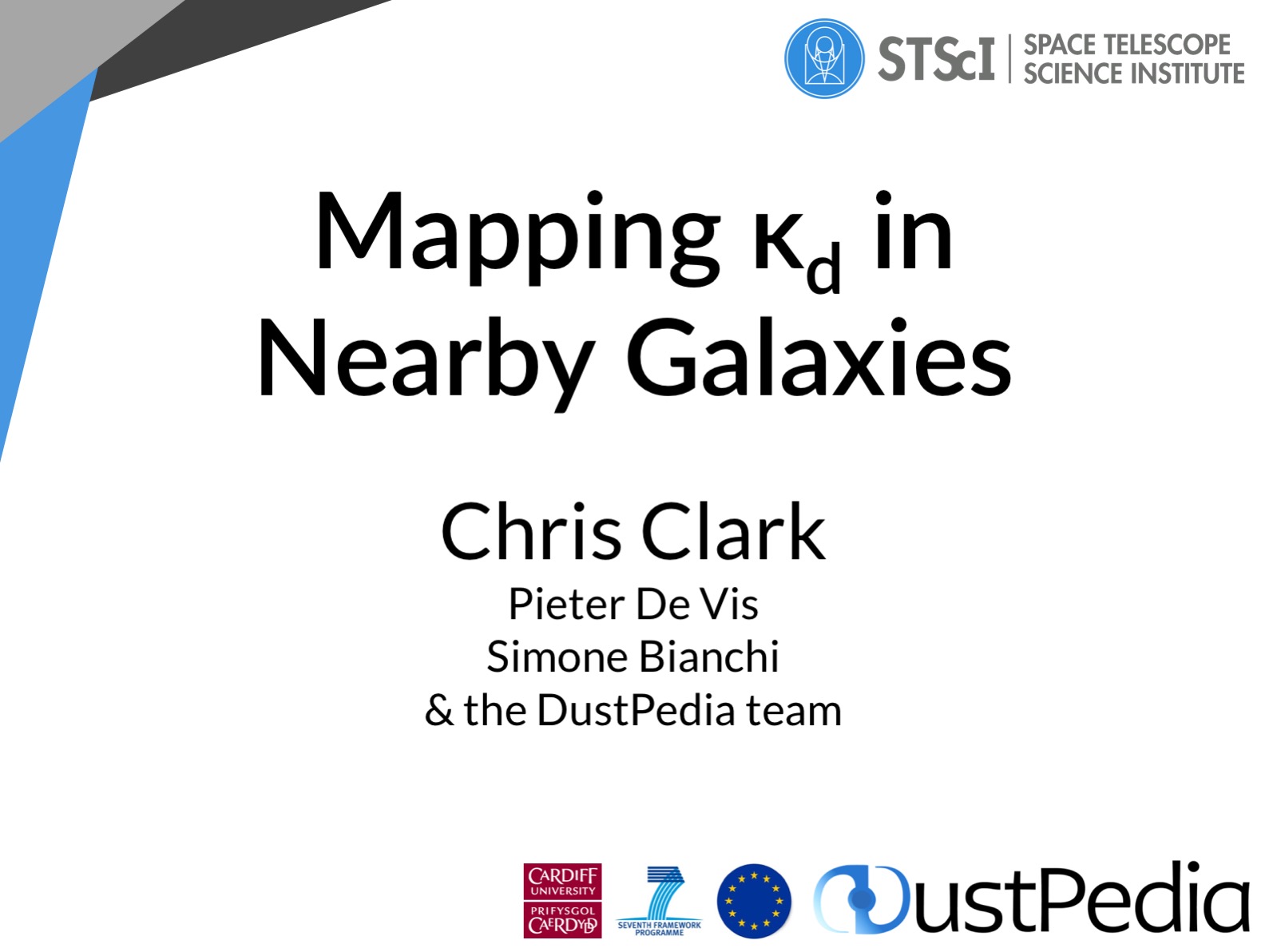
"Mapping κd in Nearby Galaxies"; given as a seminar at University College (2019) and at the East Asian Observatory (2019); abridged version presented as talk at "Cosmic Dust - Origin, Applications, and Implications" conference (Copenhagen, 2018), and "Linking the Milky Way and Nearby Galaxies" conference (Helsinki, 2019).

"DustPedia: The First Maps of κd - the Dust Mass Absorption Coefficient - in Nearby Galaxies"; poster presented at "Galaxy Evolution in the Era of Large Facilities" symposium (EWASS, Liverpool, 2018), "The Promise of SPICA" conference (Crete, 2019), and "Linking the Milky Way and Nearby Galaxies" conference (Helsinki, 2019)
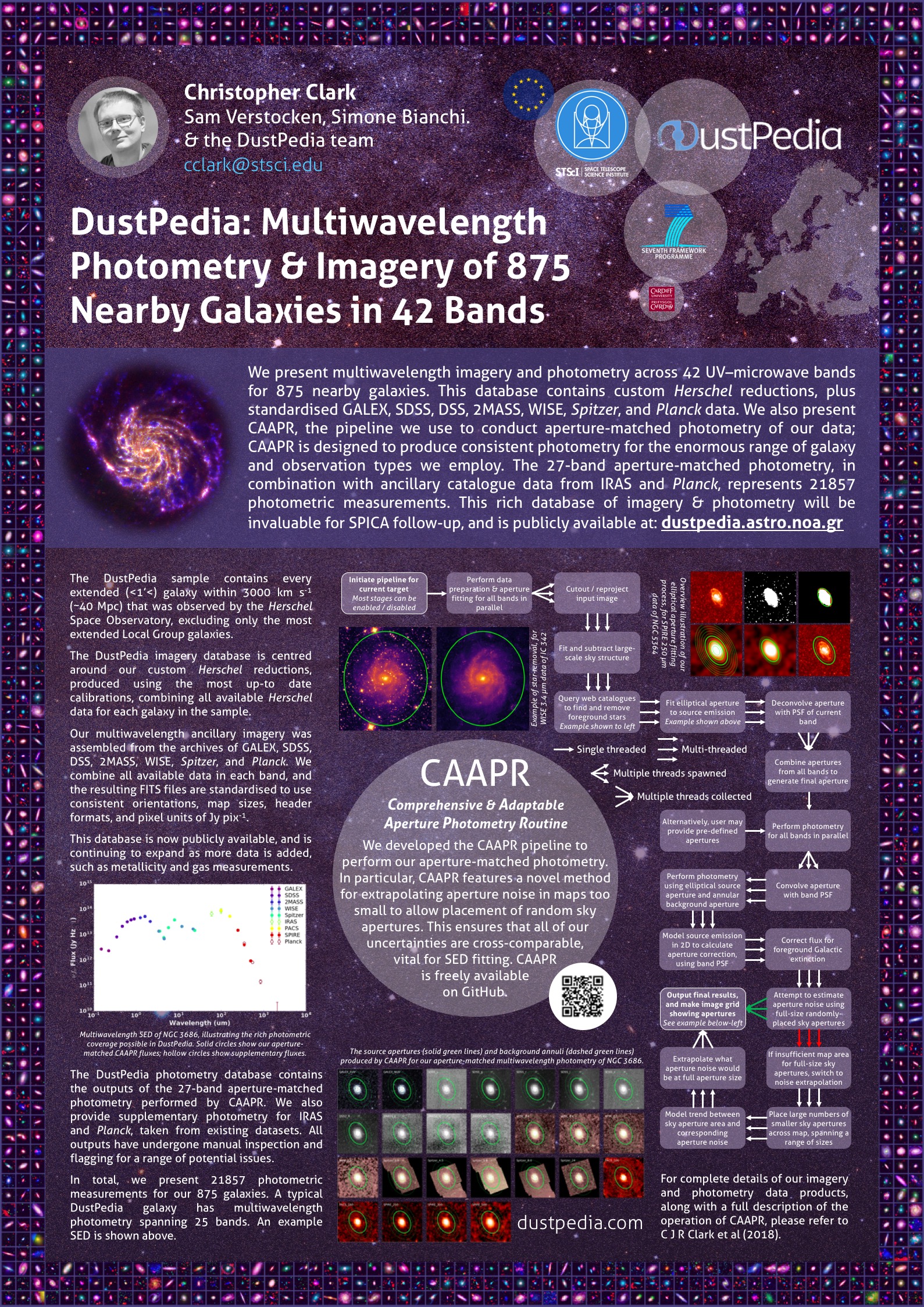
"DustPedia: Multiwavelength Photometry and Imagery of 876 Nearby Galaxies in 42 Ultraviolet–Microwave Bands"; poster presented at "The ISM as a Window Onto Galaxy Evolution" symposium (EWASS, Liverpool, 2018), "Dusting The Universe" conference (Tucson, 2019), "The Promise of SPICA" conference (Crete, 2019), and "Linking the Milky Way and Nearby Galaxies" conference (Helsinki, 2019)
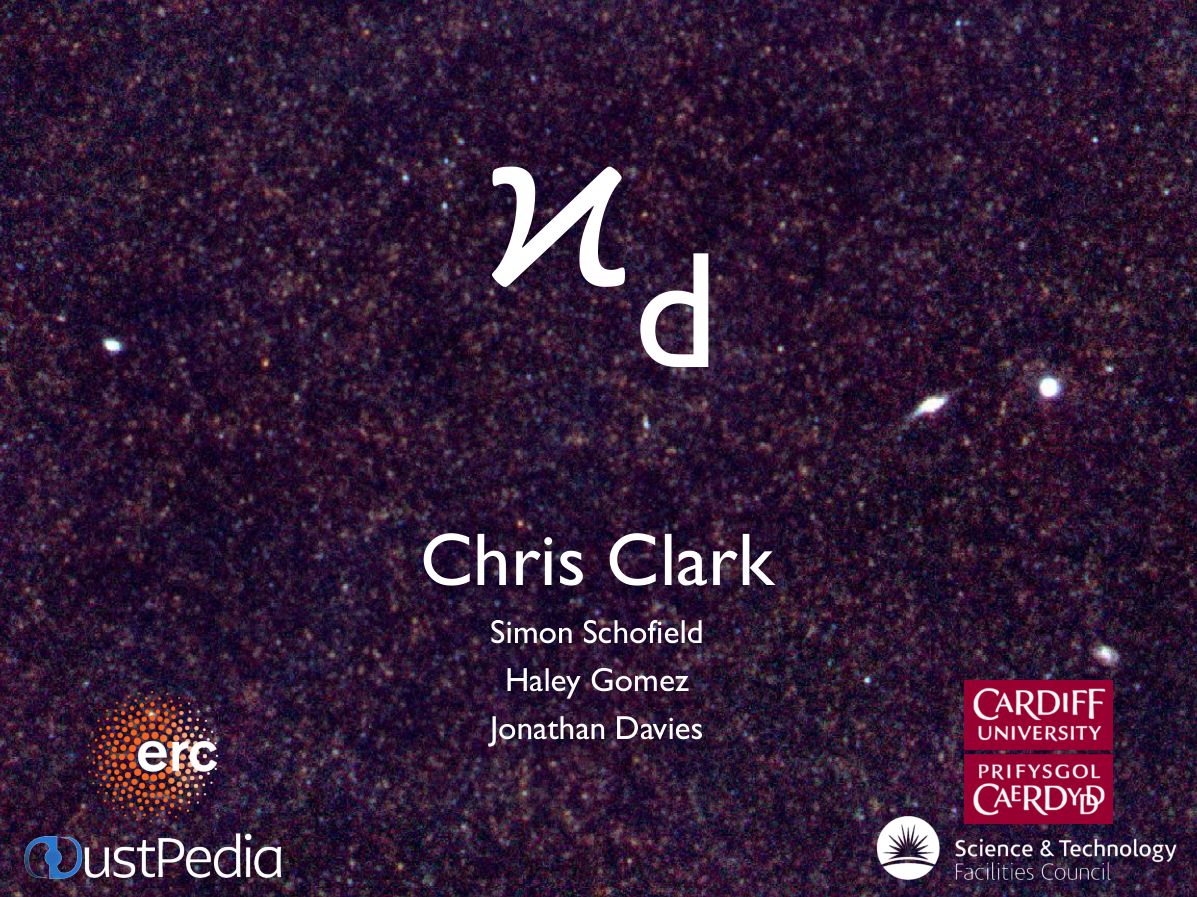
"The Guilty Secrets of Dust in Nearby Galaxies", two-part seminar given to the East Asian Observatory (2017).

"DustPedia"; Herschel-SPIRE highlight poster created to advertise the DustPedia dataset (2016).

"DustPedia"; multiwavelength highlight poster created to advertise the DustPedia dataset (2016).

"Young, Blue, and Cold: Blind Surveys of Nearby Galaxies with Herschel-ATLAS"; talk presented to "Gas, Dust, and Star Formation" conferece (Crete, 2015).
Contact
Dr Christopher Clark
Space Telescope Science Institute
3700 San Martin Drive
Baltimore, MD 21218-2463
United States of America
(+1) 410-338-6813
cclark stsci.edu
ORCiD: 0000-0001-7959-4902
Elements
Text
This is bold and this is strong. This is italic and this is emphasized.
This is superscript text and this is subscript text.
This is underlined and this is code: for (;;) { ... }. Finally, this is a link.
Heading Level 2
Heading Level 3
Heading Level 4
Heading Level 5
Heading Level 6
Blockquote
Fringilla nisl. Donec accumsan interdum nisi, quis tincidunt felis sagittis eget tempus euismod. Vestibulum ante ipsum primis in faucibus vestibulum. Blandit adipiscing eu felis iaculis volutpat ac adipiscing accumsan faucibus. Vestibulum ante ipsum primis in faucibus lorem ipsum dolor sit amet nullam adipiscing eu felis.
Preformatted
i = 0;
while (!deck.isInOrder()) {
print 'Iteration ' + i;
deck.shuffle();
i++;
}
print 'It took ' + i + ' iterations to sort the deck.';
Lists
Unordered
- Dolor pulvinar etiam.
- Sagittis adipiscing.
- Felis enim feugiat.
Alternate
- Dolor pulvinar etiam.
- Sagittis adipiscing.
- Felis enim feugiat.
Ordered
- Dolor pulvinar etiam.
- Etiam vel felis viverra.
- Felis enim feugiat.
- Dolor pulvinar etiam.
- Etiam vel felis lorem.
- Felis enim et feugiat.
Icons
Actions
Table
Default
| Name |
Description |
Price |
| Item One |
Ante turpis integer aliquet porttitor. |
29.99 |
| Item Two |
Vis ac commodo adipiscing arcu aliquet. |
19.99 |
| Item Three |
Morbi faucibus arcu accumsan lorem. |
29.99 |
| Item Four |
Vitae integer tempus condimentum. |
19.99 |
| Item Five |
Ante turpis integer aliquet porttitor. |
29.99 |
|
100.00 |
Alternate
| Name |
Description |
Price |
| Item One |
Ante turpis integer aliquet porttitor. |
29.99 |
| Item Two |
Vis ac commodo adipiscing arcu aliquet. |
19.99 |
| Item Three |
Morbi faucibus arcu accumsan lorem. |
29.99 |
| Item Four |
Vitae integer tempus condimentum. |
19.99 |
| Item Five |
Ante turpis integer aliquet porttitor. |
29.99 |
|
100.00 |





















